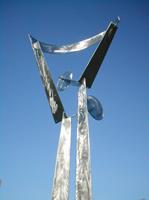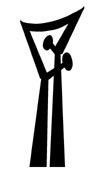
Bryn Mawr College

 |
Center Bryn Mawr College | 
|
November 8 and 22, 2002
Panama Geer
Swarm Intelligence: An Example
Slides used in the discussion are available at http://serendipstudio.org/local/scisoc/emergence/SwarmIntel.htm (requires Internet Explorer).
Swarm intelligence can be defined as "any attempt to design distributed problem-solving devices inspired by the collective behavior of social insect colonies or other animal societies."
Bonabeau et. al suggest some reasons that social insect colonies serve as motivation. Colonies can be thought of as "decentralized problem-solving systems composed of many interacting entities, in this case insects." Common problems that are solved include: finding food, building nests, efficiently dividing labor, efficiently feeding brood, etc." Some features of colonies are that they are flexible, robust and the ants have limited cognitive abilities.
Self-organization is a key feature of a swarm system. Bonabeau et. al state four characteristics of self-organization in swarms. (1) positive feedback (2) negative feedback (3) amplification of fluctuations and (4) multiple interactions. Positive and negative feedback refer to rules that promote or discourage the ants to form structures, such as pheromone trails. Amplification of fluctuations refers to an aspect of randomness that enables the discovery of new solutions. Multiple interactions refers to the many ants in a swarm, as well as their many direct and indirect interactions (stigmergy).
Three examples were presented: Langton's Ant, obstacle avoidance, and Dorigo et.al ant algorithm for finding solutions to the traveling salesman problem. The ways in which these examples exhibited (and did not exhibit) the four characteristics of self-organization in a swarm system were discussed. In addtion it was mentioned that in some of these examples, the ants used only local information while in others some global information was included.
Home
| Calendar | About
| Getting Involved
| Groups | Initiatives | Bryn Mawr Home | Serendip Home
Director: Liz McCormack -
emccorma@brynmawr.edu
| Faculty Steering Committee
| Secretary: Lisa Kolonay
© 1994-
, by Center for Science in Society, Bryn Mawr College and Serendip
Last Modified:
Wednesday, 02-May-2018 11:57:03 CDT